Asymmetrical crawling is a term used to describe a baby that is crawling in a non-typical way. It’s more common than you think and not always a reason to push the panic button.
Parents worry, but asymmetrical crawling is usually a part of the process.
During this stage, your baby is still actively developing their motor skills. That makes them clumsy and unpredictable. However, you still have to do your best to correct them.
Babies that have not been properly encouraged to crawl in a balanced way from start are more vulnerable to uneven crawling, but it’s still possible to get ahead of the problem.
We’re going to help you learn how to fix asymmetrical crawling.
Even though it’s not always a reason for parents to get worked up and concerned, it’s important to note that sometimes, yes, it could point to an underlying physical condition.
If the issue persists despite your best efforts, consult with your pediatrician.
Crawling is an important milestone for your baby. It means that your their muscles are strengthening, and that they’re improving coordination and developing spatial awareness.
If left untreated, asymmetrical crawling can lead to delayed physical development.
So, it’s important for parents to explore the causes and treatment options. In addition to that, we will provide tips on how parents can help their baby crawl in a balanced way.
What Causes Asymmetrical Crawling?
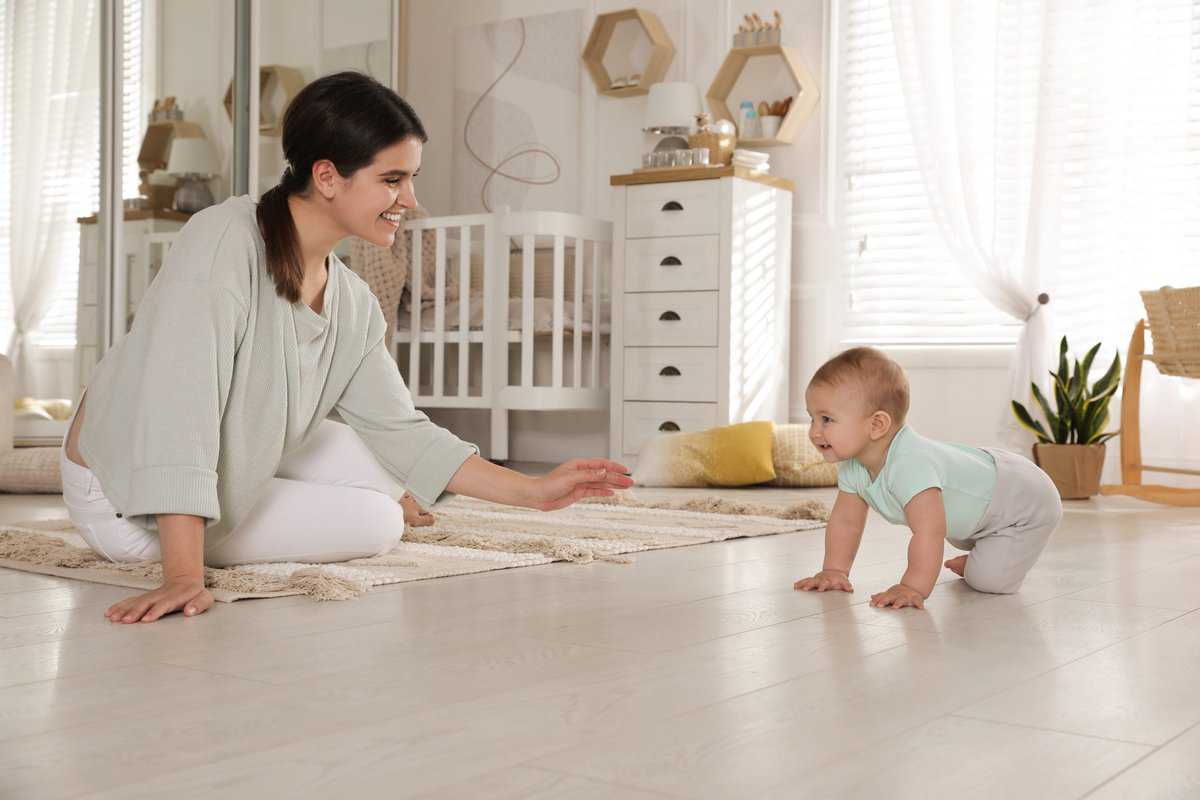
Understanding the cause is fundamental in learning how to fix uneven crawling.
That way, you can determine and plan appropriate treatments.
The causes of asymmetrical crawling can be either physical or neurological.
Most babies learn to self-correct over time, but they need proper guidance. Let’s take a moment to go over the key causes of uneven crawling if a baby isn’t growing out of it.
• Muscle weakness is the most common cause.
But, why are your baby’s muscles weak?
It could point to an injury or a medical condition that renders them unable to utilize their full strength. Has your baby fallen recently? Do they have any noticeable injury marks?
If you’re entirely sure that your child hasn’t been injured, consider muscular dystrophy.
Muscular dystrophy, however, is a severe genetic disorder that requires early treatment.
Another medical condition that may affect the communication between nerves and muscles is myasthenia gravis, which causes delays in motor skills such as crawling.
The most common treatment option for muscle weakness is physical therapy. However, in case of an underlying medical condition, your child may even have to undergo surgery.
We don’t mean to scare you, but it’s important that we cover all causes and treatment options in order to provide a comprehensive guide as to how to fix uneven crawling.
• Leg length discrepancy.
Even though leg length discrepancy is present at birth, it takes time for it to be noticeable.
Leg length discrepancy basically implies that one leg is longer than the other.
This makes it tricky for a baby to learn how to crawl. They tend to rely on the shorter leg, which causes pressure on the legs and results in a tendency to crawl asymmetrically.
Luckily, treatment options do exist. Depending on the underlying cause, they vary. For minor causes, physical therapy is recommended to help babies achieve a balanced crawl.
For more severe cases of leg length discrepancy, surgery may be needed.
Either way, if your baby’s diagnosed with leg length discrepancy, treatments exist to assure that you and your baby find a solution to the problem of asymmetrical crawling.
• Hip dysplasia.
A baby diagnosed with hip dysplasia will face difficulty crawling. Even with an early diagnosis and proper treatments, it may take time until your baby makes a full recovery.
Hip dysplasia varies in severity, but treatments exist for mild and severe cases.
In mild cases of hip dysplasia, a baby is placed in a special harness which keeps the hip joint firmly in place and allows it to develop properly, but it’s important to start early.
In more severe cases, surgery may be required.
Early identification is key in order to prevent long-term developmental delays.
• Neurological conditions.
Some of the more severe medical conditions that render babies incapable of crawling and performing physical tasks include cerebral palsy, spinal cord injuries and brain damage.
These conditions affect movement and muscle coordination.
As such, it’s important for the baby to receive professional care and treatment.
• Other causes.
Even though the causes listed above lead to asymmetrical crawling, it’s usually more simpler than that. After all, most babies learn to self-correct with time and progress.
Generally, the primary cause behind asymmetrical crawling is poor muscle tone on one side of the body, which can easily be corrected with a bit of encouragement and practice.
Other than that, you may also want to check your baby’s vision.
If they have issues seeing, they’re going to have issues staying balanced.
In conclusion, asymmetrical crawling can be caused by a variety of physical and neurological factors. It’s important for parents know the potential underlying causes.
If the baby doesn’t self-correct in a timely manner, consult your pediatrician.
However, it’s also important to know that there are different types of crawls which are considered to be asymmetrical. Knowing them helps you identify the problem early on.
Types of Crawls Identified as Asymmetrical
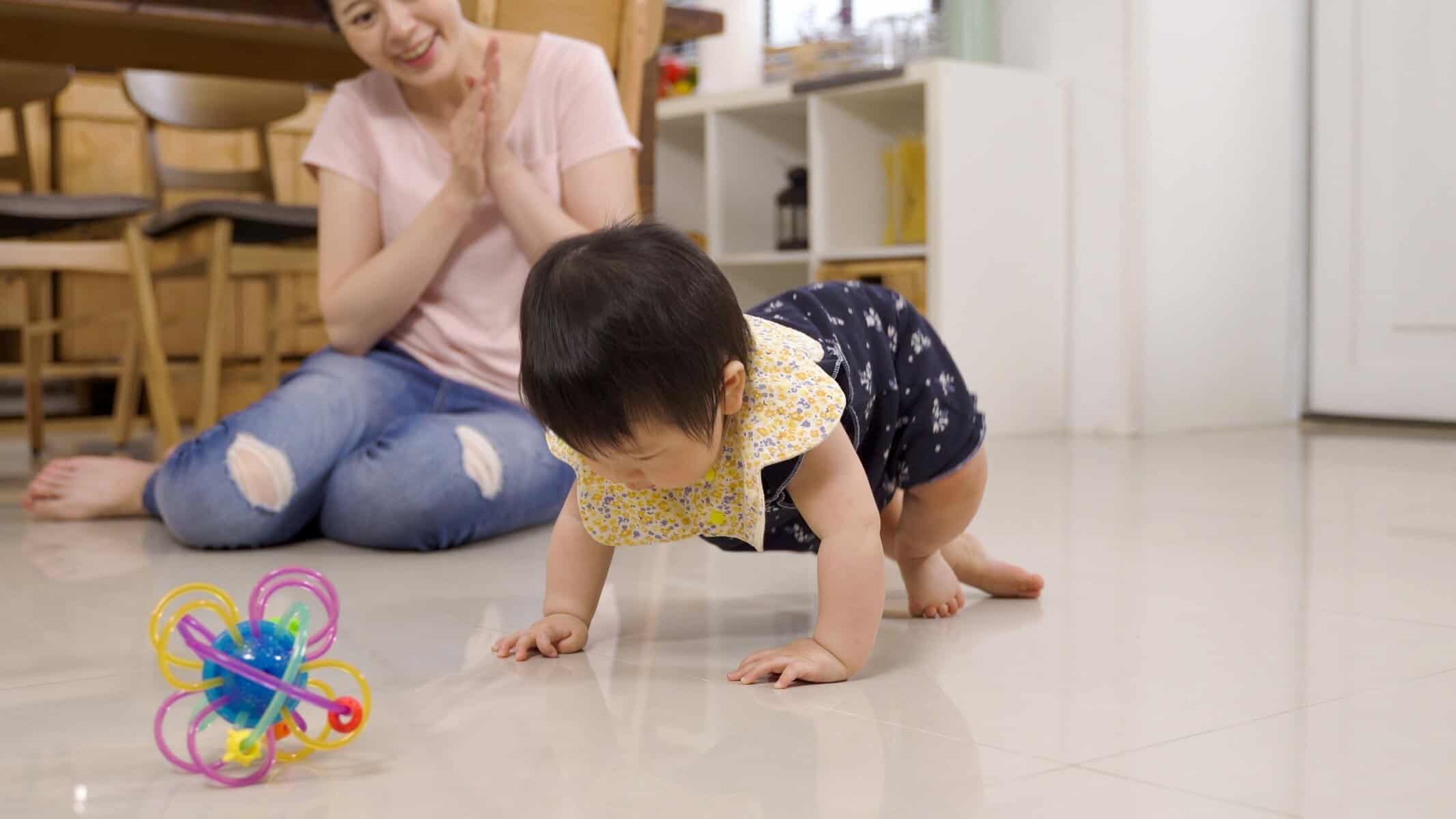
Many different types of crawls are considered to be asymmetrical. Recognizing them is crucial to ensuring appropriate development for your baby.
You have to be able to discern a natural crawling pattern from an asymmetrical one.
In some cases, the differences are glaring, but they can be subtle, too.
Here’s a breakdown of five of the most common asymmetrical crawling patterns:
• The scooting crawl is a phase most babies go through.
Usually, there’s no reason for parents to be concerned if their child scoots around.
It’s a cute way to navigate the world. They use their hands to propel the body forward, while the legs are bent and pulled towards the body. It’s asymmetrical, but natural, too.
However, if the scooting phase persists, it could point to the fact that your baby is using other ways to crawl and get around due to physical limitations or motor skill delays.
• Some babies tend to do a belly crawl.
Also known as a commando crawl, this type of asymmetrical crawling involves the baby dragging their body along the floor by using their arms and legs to propel forward.
In this case, one side of the baby’s body endures more weight, which results in an uneven crawl. Still, it’s important to note that the belly crawl is usually just a part of the process.
This pattern is common for babies that are learning how to crawl.
Even though it’s technically considered an asymmetrical crawling style, the belly crawl actually has a lot of benefits, including strengthening upper body and core muscles.
Not to mention that it also develops coordination and balance.
Even though babies quickly grow out of the belly crawl, they’re going to need your encouragement. Be patient and remember that every baby develops at their own pace.
• The all-fours crawl, also known as the bear crawl.
If your little one starts to bear crawl, there’s usually no reason for concern.
Bear crawling has its benefits, such as motor skill development. However, alternative crawling styles such as this one are considered asymmetrical and can be corrected.
In the bear crawl, babies tend to favor one side of their body more than the other.
As such, they place more weight on one arm and leg, which inevitably results in lopsided movement. You may even observe your baby crawling in circles and even stumbling.
Technically, yes, the bear crawl has benefits, because it significantly strengthens muscles in the arms, legs and core. This style helps babies explore the environment around them.
However, it’s important not to encourage abnormal crawling, despite the benefits.
Make sure that your little one is learning how to crawl forward in a natural way.
• Some babies prefer to crab crawl.
In the crab crawl, a baby uses arms and feet efficiently, but only to move sideways or backwards. Nothing too odd about this one, because this style of crawling is beneficial.
So long as your baby’s moving around and exploring, they’re happy.
Despite the asymmetrical nature of this crawling style, it has many benefits. A crab-crawling baby is actively developing their motor skills and strengthening muscles.
Although it’s normal for some babies to do this, you should still work to incorporate a more natural crawl pattern. The best way to do that is to work on it during tummy time.
Yes, it may look a bit strange, especially if your baby tends to move backwards, but there’s nothing inherently wrong about crab crawling. It’s a fun way for babies to get around.
• The rolling crawl.
In this style, babies roll their entire body over in repetition so as to move forward.
It’s also known as the log roll or barrel roll.
A lot of babies do the log roll when they’re starting to learn how to crawl. Usually, they start by lying on their back, bringing one arm and leg over to the other side of the body.
They repeat the process to move around, which results in asymmetrical crawling.
Like most crawling patterns, there are certain benefits to this physical movement, but you should still encourage your baby to learn how to crawl naturally on their knees.
• Other types of crawls.
Sometimes, a baby’s crawl is so unique that it doesn’t necessarily fit into categories.
However, aside from the ones mentioned above, the most popular asymmetrical crawling styles include club crawling, hitch crawling, bottom scooting and bunny hop crawling.
All of these types of crawling are considered asymmetrical and abnormal.
However, they’re not going to cause any developmental issues for your baby.
The problem arrives if the problem persists for a longer period of time. In that case, babies tend to develop muscle and skeletal issues, which makes learning to walk harder.
While babies usually self-correct in a timely manner, it’s useful to know how to fix asymmetrical crawling, and to correct the pattern if the problem happens to persist.
How to Fix Asymmetrical Crawling
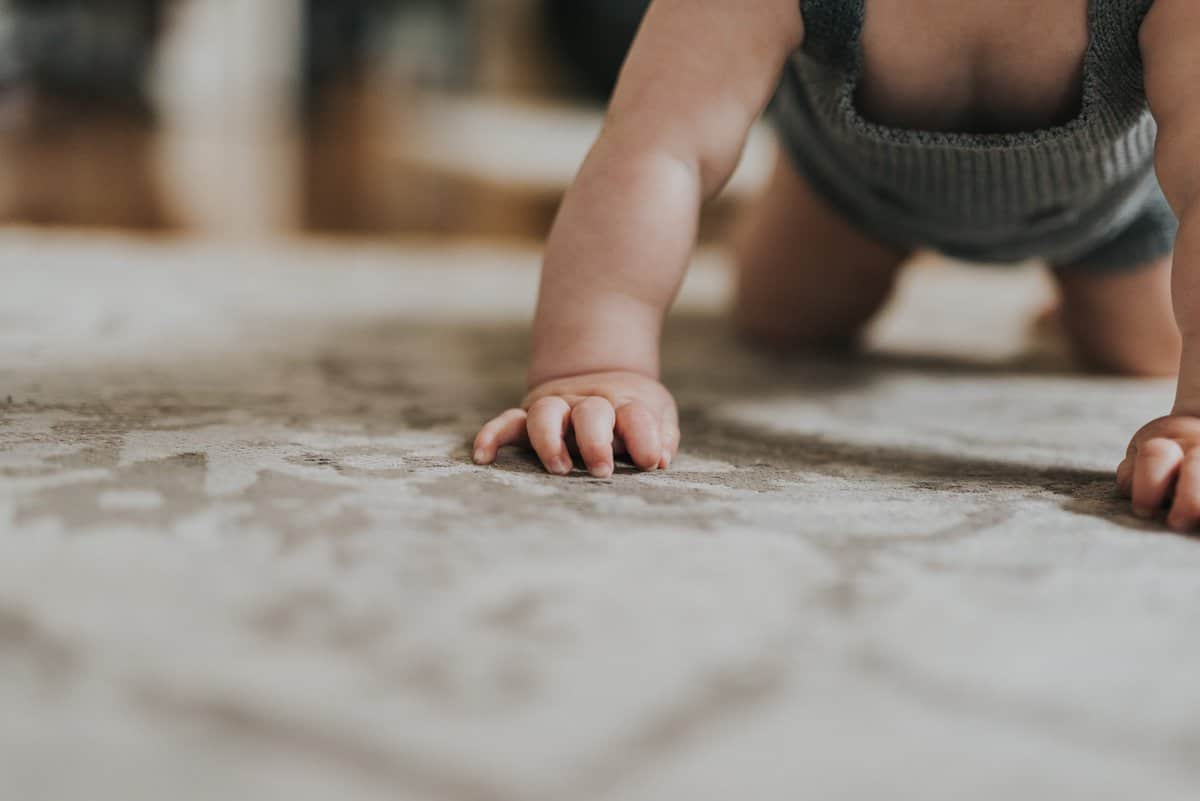
Babies crawl in all sorts of ways. A baby can crawl asymmetrically, but that doesn’t mean that a certain crawling pattern will cause them problems. They will likely grow out of it.
However, you can still take proactive steps towards fixing asymmetrical crawling.
In fact, you’re encouraged to do so, especially if the issue outstays its welcome.
• Tummy time is a crucial development activity for your baby for future skills.
During tummy time, a baby strengthens their core, upper body and hip muscles. If a baby doesn’t get enough tummy time, there’s a chance that it may lead to developmental delay.
By incorporating tummy time into your routine, you ensure that your baby gets all the physical exercise they need. Start with short sessions and work your way up gradually, and your baby’s future skills will be fulfilled.
• Use toys to encourage your child.
Every baby is naturally drawn to toys like a magnet.
Using toys to encourage your baby to crawl in a forward direction is a great way for a young baby to learn how to use both arms and legs equally and improve coordination.
You may want to choose toys that are visually appealing and interesting to your child.
Place the toy just out of your baby’s reach. When they do manage to reach the toy, offer praise and positive encouragement. Repeat the process, but don’t exhaust your baby.
To motivate them, you can get down on the floor and play with them. Encourage your child to crawl towards you and provide support and correction if and when necessary.
Remember to offer positive reinforcement for every time your baby reaches the toy.
Be patient. Every baby develops at their own pace. It’s normal for some babies to take longer to learn how to crawl naturally. On the other hand, some get the hang of it sooner.
Patience and understanding are, therefore, essential.
• Change the environment.
Sometimes, mixing things up offers great results regarding crawling baby.
If you want to take positive steps towards ensuring your baby overcomes abnormal crawling, make sure to switch up the environment and to provide additional challenges.
For example, the crawling surface plays a huge part. On what kind of surface is your baby learning how to crawl? Carpet-crawling differs notably from crawling on hard surfaces.
If you want to get creative, you can even design an obstacle course for them to navigate.
Just make sure that you prioritize your baby’s safety. That implies using pillows, blankets and soft items that won’t harm your baby should they accidentally stumble into them.
If your baby lacks motivation, changing the room may yield positive results.
Sometimes, all they need is a change of scenery. Besides, a new room implies a new challenge for your little one, because they have to navigate new and foreign terrain.
That inevitably improves their spatial awareness.
• Support your baby’s form and movements.
By getting down on the floor and using your arms and knees to crawl alongside your baby, you set an example for them to mimic in an attempt to fix asymmetrical crawling.
That way, you’re actually modeling the correct form.
You can also directly correct your baby’s form whenever they stumble or lose support.
However, it’s important that you do so subtly, because your baby needs to know that they’re mastering the art of crawling on their arms and knees forward on their own.
When you’re actively engaged in this activity, positive reinforcement is a must.
The way you encourage your baby is up to you. You can use words or even hugs.
• Physical therapy.
In some cases, especially if there’s a mild underlying cause, it will be necessary for your child to go to physical therapy in order to help them overcome asymmetrical crawling.
First things first, you will need to actually go see a physical therapist.
Doing so will help you assess your baby’s muscle strength and gross motor skills.
Based on the therapist’s evaluation, you will get an individualized treatment that’s going to help you improve your baby’s spatial awareness, muscle strength and coordination.
If not, your physical therapist may just give you some peace of mind, instead.
If they tell you that you have nothing to worry about, then you probably don’t.
Still, most treatment options in regards to asymmetrical crawling include hands-on therapy to help a baby learn to crawl naturally. This varies from massages to stretching.
There are even some medical devices that you can use, if necessary.
However, the most important aspect is going to be education. As a parent, you need to learn the ins and outs of a natural crawling pattern – and how to teach it to your kid.
So, be willing to learn and to be extra patient.
• Seek professional advice and guidance.
In nine out of ten cases, asymmetrical crawling is a natural phase.
However, if you’re a parent that worries too much, you don’t have to torture yourself. Consult with a pediatrician in order to determine the severity of your child’s issue.
Even if there’s an underlying condition involved, you’re going to get adequate treatment.
A doctor’s evaluation is always more useful than your own personal observation.
Take the time to schedule an appointment so that you can stop worrying and get to the bottom of the issue. If there’s a problem that needs fixing, you will get the help you need.
In Conclusion

For the most part, asymmetrical crawling is a common obstacle that many parents have to deal with. Various factors can cause it, but it’s usually nothing serious.
Still, if the problem happens to persist, you should consult with your pediatrician.
Even if asymmetrical crawling isn’t as dangerous as it maybe sounds, there are still ways for you to refine your child’s movement and to help them by encouraging normal crawling.
From using toys to helping your child stay motivated to encouraging exploration by switching up the environment and adding obstacles – there’s a lot you can do.
It may sound strange, but there are certain benefits to asymmetrical crawling.
It is a self-learning and body awareness part of your child’s development. As they work to self-correct, their muscles strengthen, their coordination improves and their gross motor skills enhance.
Parents often make the mistake of associating abnormal crawling with developmental delay. That’s not always the case. Asymmetrical crawling is often, in fact, just a phase.
A baby crawling on their arms and knees should be a fun and memorable milestone for every parent. Therefore, if you’re overstressing, don’t hesitate to consult a professional.
They can give you the relief you need by providing appropriate answers.
All in all, most cases of asymmetrical crawling can easily be resolved.
In doing so, you also get the benefits of this strange and sometimes outright comedic phase while also promoting motor skills development and helping your child grow.

Mother of three and a primary school teacher. I’ve always loved being around children and helping them, so I chose my path as a teacher. It is sometimes hectic with three children, but I am 100 percent into it and wouldn’t change it for anything in the world.

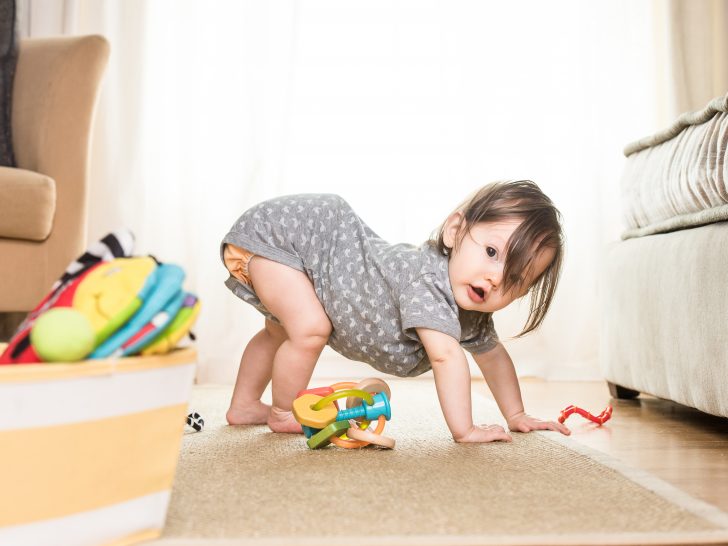
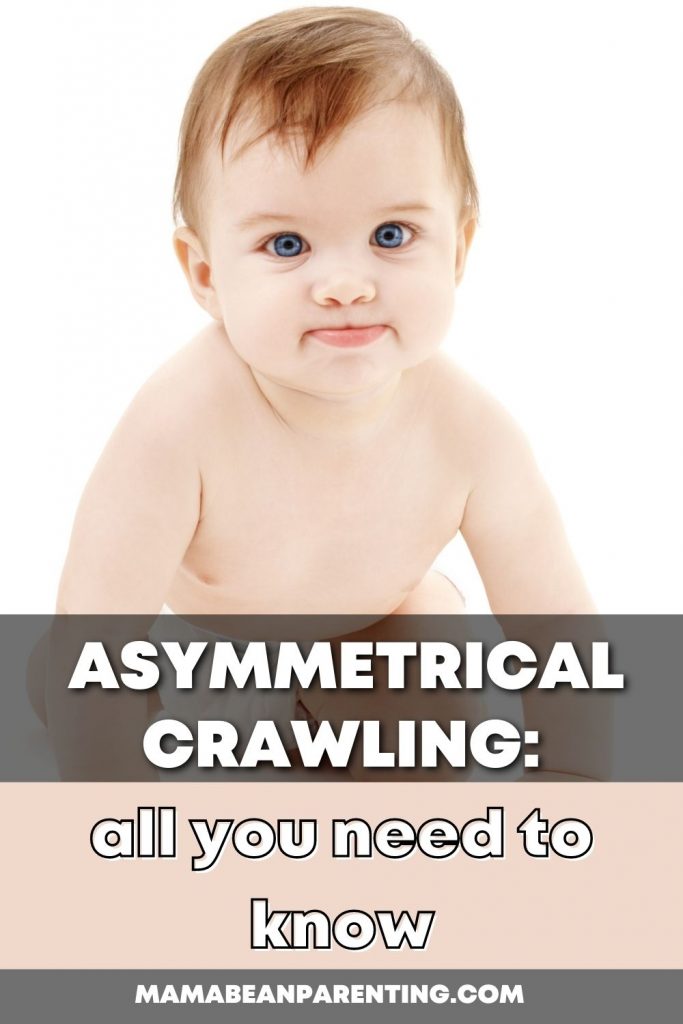
Why Do Babies Sleep With Their Butt in the Air? • Mama Bean Parenting
Friday 3rd of March 2023
[…] Babies crawl in many ways, sometimes asymmetrically. […]